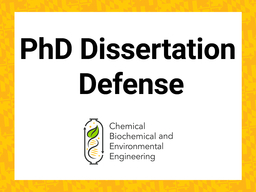Location
Online : WEBEX
Date & Time
July 17, 2020, 12:30 pm – 4:30 pm
Description
Yang Liu, PhD Candidate
TITLE
Theory and practice of industrial applications of chromatofocusing for monoclonal antibody purification
ABSTRACT
Chromatofocusing is a special form of ion-exchange chromatography that uses a self-generated pH gradient that travels through the column as a set of retained pH waves. The pH gradient used in the method is internally generated and formed dynamically inside the column (as opposed to using external mixing as in traditional ion-exchange chromatography) by employing buffers with properly selected components. The nonlinear adsorption behavior and displacement effect under mass overloaded conditions that take place in the method make its application particularly interesting for realistic, complex industrial purifications of monoclonal antibodies (mAbs), which are one of the most important new types of biopharmaceuticals.
Protein A affinity chromatography is commonly used as the initial capture step in a purification process for mAbs, However, the high cost and propensity for ligand leaching of this method has led to recent interest in replacing this step. This thesis investigates the use of both chromatofocusing and ion-exchange chromatography using externally created gradients as alternatives to protein A chromatography for the initial capture step in an overall purification process for antibody products. The specific conditions employed for the capture step for the case of chromatofocusing were selected on a rational basis using a computer-aided buffer design method and a process development tool that incorporates a 3D analytical separation method. Alternative operating conditions were compared experimentally with regard to the product yield and product purity. Results from this study indicate that both chromatofocusing and ion-exchange chromatography with external gradients are useful alternatives to a protein A chromatography capture step in many practical cases. This is especially true for the case of chromatofocusing when it is possible to exploit the ability of the method to create complex gradient shapes that are self-forming inside the column.
In addition to the use of chromatofocusing in the capture step for mAbs, this study also investigates its use as a polishing method after a protein A capture method. In particular, chromatofocusing as a polishing method was evaluated for its ability to remove host cell proteins (HCPs) and product aggregates that are retained after protein A chromatography. For this purpose, a 2D analytical process development tool was created and employed for selecting appropriate chromatofocusing pH gradients and column packings.
Chromatofocusing in previous work by others has mainly employed the bind-and-elute mode. However, to increase the loading capacity, in this study chromatofocusing was also investigated in the overload-and-elute mode. To assess the results obtained, column effluent fractions were collected from both the frontal chromatography loading step and the chromatofocusing elution step. To improve the purity of product collected from this latter step when using the overload-and-elute mode, an auxiliary column was added after the main column, and a column switching method was applied during the elution step. Results from this study indicate that chromatofocusing is useful for removing HCPs and aggregates simultaneously in a polishing step. In addition, evidence was obtained showing that anion-exchange chromatofocusing has the potential to disrupt mAb-HCP interactions and remove the so-called “hitchhiker” HCPs from the product.
Instead of polyampholyte buffers of the type that were employed when chromatofocusing was initially invented, the buffers used in this work consist of relatively simple, well-defined mixtures of buffering species. For process simplicity, a system with three buffering species was used for all the experiments in this work, with one buffering species in common between the starting and elution buffers. Two approaches were used and compared for the design of a chromatofocusing pH gradient. One approach employed a mechanistic model based on the local-equilibrium assumption and the coherence conditions. The other approach employed a non-mechanistic model based on a machine-learning, linear regression algorithm. A buffer pool consisting of five different buffering species was employed, and both computational methods were able to automatically select the optimal set of three buffering species for a given application. Results indicate that with a limited number of training experiments, which is the case considered here, the design and prediction of chromatofocusing pH gradients based on a mechanistic model is more reliable than using a linear-regression model. However, both approaches are useful process development tools depending on the circumstances that apply. The modeling and design software produced in this study was developed using Julia, which is a new programming language designed for high-performance computing and machine learning applications.
AGENDA
